If you’ve got a Big Rig RV, planning your travel routes requires some extra thought and preparation. Since we’ve been living and traveling full time in a Big Rig RV for nearly 20 years, we feel fairly well qualified to offer some insight gained through our considerable experience. So today we’re sending out 7 of our favorite big rig RV route planning tips & tricks.
Let’s hit ‘em up one by one, but first, let’s clarify exactly what a “Big Rig” is!
- 1) What Size RV is Considered a Big Rig RV?
-
2)
Tips To Know Before You Go: Big Rig RV Route Planning
- 2.1) Make Sure You Have a Reliable Roadside Assistance Plan
- 2.2) Use an RV-Safe GPS to Avoid Low Clearances and Steep Grades
- 2.3) Avoid Driving Through Large Cities
- 2.4) Avoid Driving at Night
- 2.5) Plan Your Fuel and Food Stops in Advance
- 2.6) Read Campground Reviews or Contact Campgrounds Directly
- 2.7) Walk the Campground/Site Before Driving In/Parking
- 3) Do You Have Any Big Rig RV Route Planning Tips & Tricks Up Your Sleeve?
What Size RV is Considered a Big Rig RV?
A Big Rig RV is usually classified as an RV that’s longer than 40’. Our ‘05 Newmar Mountain Aire diesel pusher is 43 feet long, so we’re officially in the “Big Rig” class.
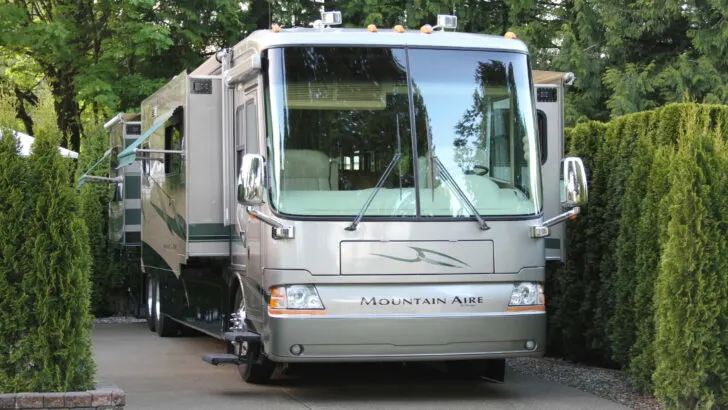
Our rig is a 43′ Class A Diesel Pusher and is definitely classified as a “big rig RV”, a term used to describe large RVs that are longer than 40′.
It’s important to note that it doesn’t matter which type of RV you have – if it’s over 40’ long, you’ve got a Big Rig RV. For example, if you’ve got a 5th wheel that’s longer than 40’, you’ve got a big rig RV.
Tips To Know Before You Go: Big Rig RV Route Planning
You’ve picked out your dates and you’re excited thinking about all the fun you’re going to have on this trip. But don’t leave the important details until the last minute. There are a number of things we recommend you plan for ahead of time, as part of your Big Rig RV route planning.
Make Sure You Have a Reliable Roadside Assistance Plan
One of our top tips for big rig RV route planning is to get yourself a good roadside assistance plan.
You’re driving or towing a very heavy home-on-wheels, and things can go wrong. Hopefully, nothing will, but you want to be prepared for the possibility. Part of that preparation means having a roadside assistance plan that provides for your big rig to be towed if necessary.
And don’t think it can’t happen to you. We’ve got a professional driver on board and we went 13 years without ever getting stuck, and we boondock in some crazy remote places. Like REALLY remote for a 43’ Class A diesel pusher.
No matter where you travel, you need a reliable roadside assistance plan as your safety net. If you’re wondering how we know, just watch the video below, and you’ll see why we appreciate our Coach-Net plan so much. (And see our post for more information on some of the best RV roadside assistance plans available.)
Use an RV-Safe GPS to Avoid Low Clearances and Steep Grades
An RV-safe GPS is one that’s capable of taking the size and weight of your RV into consideration, finding the best route available based on those details. They also provide warnings to make you aware in advance of steep grades, sharp curves, weight limits, and the like.
Note that even RV-specific GPS units may not provide all information in all areas of travel, and nothing can take the place of an observant, defensive driver.
- Large 8" RV navigator with high-resolution touch display and options for portrait and landscape mode.Control Method:Touch,Application,Voice.Special...
- Custom routing considers the size and weight of your RV then finds the best route (not available in all areas)
Another option is a good trip-planning app that allows you to specify the parameters of your particular RV. A good example would be RV Trip Wizard, part of the RV Life PRO suite of tools.
With this app, you can enter the height, weight, length, etc. of your RV, and you can also enter your driving preferences. These might include such parameters as toll avoidance, average time & distance traveled per day, and others.
These types of apps allow you to do your big rig RV route planning taking the specifics of your rig into account.
RV Trip Wizard lets you integrate with the RV Safe GPS portion of the suite, allowing you to pre-plan a route that avoids low overpasses, propane-restricted tunnels, steep grades, and bridges for which your RV might be overweight.
So you can pre-plan your entire trip in RV Trip Wizard and then access the trip plan from the RV Safe GPS.
If you’re interested in taking advantage of the features of the RV Life Pro package, we’re happy to be able to offer this coupon code to our readers, saving you 25% on the cost of an annual subscription.
RV Life Pro membership provides access to a suite of valuable tools (each one separately worth the cost of the whole package), including: RV Trip Wizard (trip planner); RV Safe GPS app (for...Show More
RV Life Pro membership provides access to a suite of valuable tools (each one separately worth the cost of the whole package), including: RV Trip Wizard (trip planner); RV Safe GPS app (for RV-specific navigation); CampgroundReviews.com (user reviews of RV Parks & campgrounds); iRV2.com (community forums); RV Life Maintenance Tracker (maintenance schedule tracking), and RV Masterclass (excellent educational material for all RVers).
Read Our Post All About The RV Life App
Save 25% on your first annual subscription to RV Life PRO by clicking the button. The discount will be applied when you click through to the payment page. Show Less
Avoid Driving Through Large Cities
When you’re driving a big rig RV, navigating through big, busy cities can be stressful and can be the cause of significant delays in your travels due to construction, traffic, frequent stops, and longer routes to avoid low-clearance bridges. And if you need to stop for fuel, there’s no guarantee that you’ll be able to find a station that can accommodate your big rig.
For these reasons, we recommend planning your big rig RV route to avoid bigger cities whenever possible. This is a worthwhile endeavor even if it adds a few miles to your trip.
Are you wondering whether the RVgeeks, with the distinct advantage of a former professional bus driving instructor (Peter) at the helm, practice what we preach in this area? For the most part yes. While we do occasionally drive our rig into large cities, we reserve that for those rare occasions where our destination is actually within that city (like pulling our rig up in front of our cousin’s house in Seattle for a visit).
But even though Peter spent a decade operating tour buses, and training new bus drivers (in New York City!), we’ve never actually driven our motorhome into NYC. And we likely wouldn’t. Even though we could theoretically easily manage it, our RV isn’t a bus that belongs to someone else’s company. It’s our home! So why risk it unnecessarily?
Avoid Driving at Night
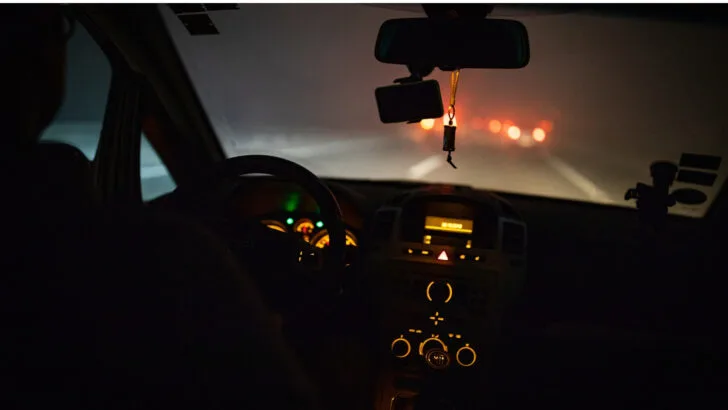
It’s a good policy to avoid driving at night to the extent possible. This helps to avoid driver fatigue as well as accidents with wildlife and breakdowns or emergencies after dark.
If at all possible, avoid driving at night. Doing so, you’ll avoid lots of potential for wildlife in the roadway, fatigue, and eye strain. You’ll also be making sure that services are available should you need help for a breakdown or anything else.
In our post full of tips for RV newbies, we suggest following the 2/2/2 rule or the 3/3/3 rule, both of which involve not driving at night and not driving for too long.
The 2/2/2 rule refers to driving no more than 200 miles a day, stopping every 2 hours, and arriving at your daily destination by 2:00 PM. The 3/3/3 rule is similar, though as you might expect, it refers to traveling no more than 300 miles in a day, stopping every 3 hours, and arriving at your destination by 3:00 PM.
We also point out the obvious, which is that arriving at your destination after dark makes it a whole lot more difficult to maneuver your rig into the site and get it set up. This is especially true of big rig RVs. Overhanging branches and other obstacles are much harder to see in your mirrors at night… and even a diligent spotter can miss them, resulting in unnecessary damage to your RV.
Plan Your Fuel and Food Stops in Advance
Planning your fuel and food stops in advance is more helpful than you may think. Not all fueling stations or food service locations can accommodate a big rig RV. And you don’t want to find that out at the last minute.
This is another way a tool like RV Life Pro’s RV Trip Wizard (25% off with code RVGEEKS!) can be very helpful because it allows you to see the street view (you can do the same using Google/Bing Maps) which will help you decide whether or not you’re comfortable maneuvering your big rig into that location.
Here’s how that works:
In the Trip Wizard, you’ll simply right-click on the spot on the map where you want to see Street View. Next, choose the “Google Street View Here” option from the contextual menu that appears, and a new tab with Google Street View should load, centered right on the point you clicked on the map in Trip Wizard.
If you don’t have RV Life Pro/RV Trip Wizard, another option is to use Google Maps (either on the web or via the Google Maps app on your smart device) and look at Street View for any address or point available on the map.
Read Campground Reviews or Contact Campgrounds Directly
Reading campground reviews is always important, and perhaps no more so than when you’re driving a big rig RV. Reviewers who have actually driven a big rig into a particular campground are likely to give you a very good idea of exactly how accessible the campground is and how easy or difficult it is to move a big rig through the campground and into a site. They’ll often even tell you exactly what sites to request or avoid (which can help circumvent the whole problem by ensuring you reserve the best one right from the start).
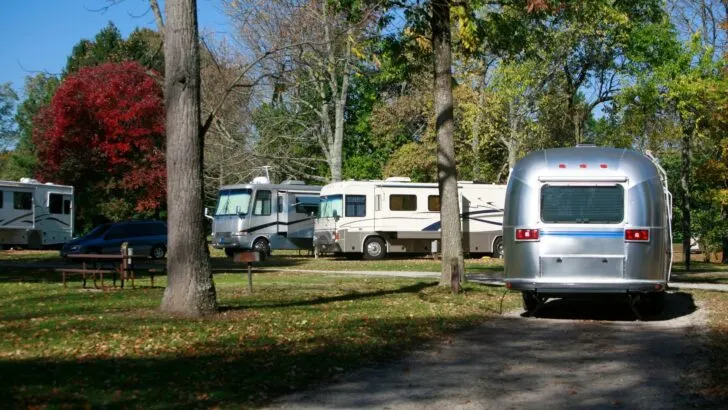
Reviews from fellow RVers who have already navigated a big rig RV into a campground you’re interested in visiting can give you a real-world assessment of what challenges you may encounter.
And when you’re in a big rig, it also makes sense to call ahead to make sure (despite what you read) that they’ll accept a rig as big as yours and that they’ll have a site available for you upon your arrival. You’ll also want to make sure they have good big rig access (which is different from just having a site large enough to accommodate a rig the size of yours).
“Big rig access” is a term used to describe the approach to a campsite that large RVs should be able to access. How tight are the streets; how sharp are the turns; how low do the trees overhang; are the sites angled, or the entrances rounded, to make big rig entry easier?
A campsite may be wide enough and long enough to accommodate your RV, but if you have to navigate your big rig through tight, narrow turns, avoiding trees, large rocks, and low-hanging branches in order to avoid damaging your RV, you’ll still want to avoid that campground or that area of the campground.
So, “big rig friendly” is great, but part of your big rig RV route planning really must include big rig access at campgrounds so that you know you’ve got safe and relatively easy access to your big rig friendly site!
Walk the Campground/Site Before Driving In/Parking
Our general practice upon arriving at a campground (particularly those in the woods) is to stop short of entering — wherever we can safely park the rig. We then get out and walk the route we’ll need to travel to get to the campsite. This way we can survey access to the site as well as the site itself before bringing our 43’ diesel pusher in.
And that’s a tip we think all big rig RV owners may want to employ when arriving at a new location, especially in State, National Park, or National Forest Campgrounds. They may have sites that can accommodate your big rig, but can you get to them without damaging your RV… or something in your RV’s path?
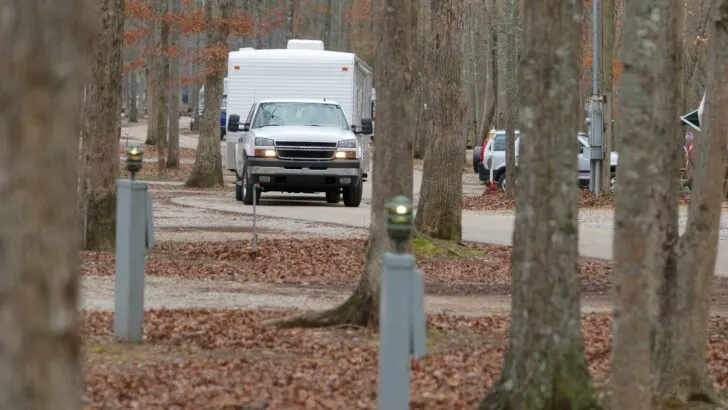
If you’ve got a big rig or even a relatively large travel trailer, it can be very helpful to park your rig and walk the path to your campsite to scope out any obstacles or difficult passes you’ll encounter when you drive your rig to your site.
Pro Tip: If the campground is really large, consider disconnecting your toad and driving around the campground without the RV to scope things out.
Bonus Tip: If you ever arrive at a campground only to find that they really don’t have the big rig access you require to safely maneuver your rig into and out of the campsite, don’t panic. You can always find a quick overnight spot, do a little research, and regroup once you have a chance to sit down and relax after your long day of driving. Keep our post on free overnight RV parking handy just in case! This is yet another reason to avoid driving at night. Arrive early!
Do You Have Any Big Rig RV Route Planning Tips & Tricks Up Your Sleeve?
If you’ve traveled in a Big Rig, we’d love to know your big rig RV route planning tips and tricks! Please share your experience in the comments section below.
Geek Out with Us Every Week
Join our newsletter to learn about all things RV-related. Every week we offer free tips, tricks, product reviews, and more to our online community of RVers. So, whether this is your first time on the road or you’re a seasoned expert, we’d love for you to geek out with us!



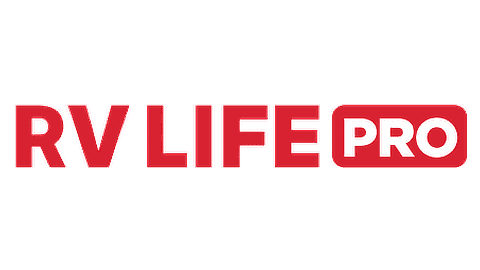
Julie Schwartz
Monday 12th of June 2023
Love the comments about Google Maps and satellite. I am new to RVing and only have a 29ft class C. Not a big rig but a newbie to the experience. Planning our 1st long road trip and the advice has been well received. Wanted to ask I have Roadtrippers Plus as a planner and GPS app. Is this adequate or should I research your recommendations?
TheRVgeeks
Monday 12th of June 2023
Hi Julie... the first long road trip is always exciting! Hope you're enjoying the anticipation of hitting the road! We'd suggest using what you've got and seeing how it works for you. Of course, as a GPS backup, you can always use Google Maps as a backup (though, of course, it doesn't have RV-specific routing). Then, see if you're happy with how it all worked. There's no sense spending more money than you need to have tools/apps/software you don't use.
Jose
Monday 12th of June 2023
The reason I bought a class A was because of you guys. I watched every video sometimes 2 / 3 times my wife would laugh and say I don’t think anything has changed since you watched it yesterday ????So I just wanted to say THANK YOU!!
Mickey Ryerson
Tuesday 13th of September 2022
I enjoy reading all of your tips and advice for big rigs - we have a Newmar DS 2020
TheRVgeeks
Thursday 15th of September 2022
Thanks so much, Mickey! Hope you're enjoying your Newmar!
TomG
Wednesday 22nd of June 2022
With a 35 foot DP towing, I am most always fueling up at stations/truck stops in the Open Roads (TSD) network. If I'm planning to stop for fuel that day, I use Google Maps app with Satellite View to scout out the entrance/exit and main road within the truck stop. Open the app, tap the arrow for current location and switch to Satellite View. Most of the major stops have signs directing you to the exit, once you filled up. Again, Satellite View helps find the way out. If we plan to park and eat lunch, be respectful of the truckers and don't park in the Reserved slots. Since we are flattowing and can't back up, I use the Satellite View to see if this truck stop has any pull thru lanes. Older, smaller ones don't which isn't a problem for the 18 wheelers, but it is for us. If there are no pull-thru temporary lanes, I park way over to the side, somewhere out of they, so that we don't keep the truckers from maneuvering. Met some friendly truck drivers and a few asked about our rig.
Kurt Fischer
Wednesday 22nd of June 2022
Very good information. My cell phone doesn't have enough space for rv trip wizard or GasBuddy. The factory navigation let's us select bus, so we get the best routes to navigate. We had a 2000 mountain aire but got rid of it.